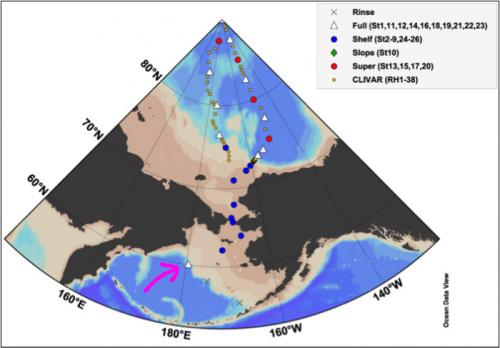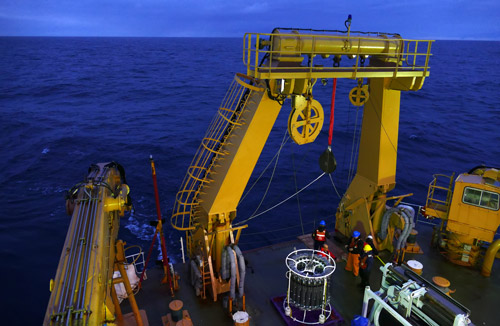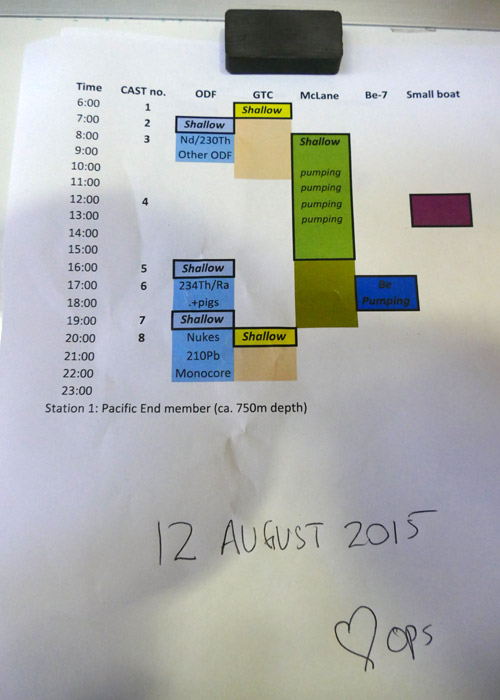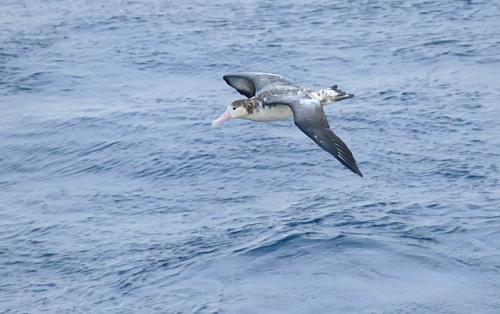Cruise Day 4
Speed 1.1 knots (kts)
Course 203° (SSW)
Location 60.23° N, -179.04° W
Depth 716 m
GO DEEPER DISCUSSION: (see previous journal for the questions.)
Sunbeams emanating from gaps in the clouds are called crepuscular rays. The beams are actually nearly parallel, but a viewer’s perspective makes them appear to converge at the position of the Sun for the same reason parallel railroad tracks appear to converge on a distant horizon.
TODAY’S JOURNAL:
We reached the location of our 1st full sampling station this morning, a site chosen for its central Bering Sea position along a continental slope. We are within 1 degree of 180° Longitude, so if we went just a wee bit more west we’d be in the eastern hemisphere. Right now we are 47 nautical miles (nm) closer to Russia than to the nearest US soil on St. Matthew’s Island, with Cape Otvesnyy, Russia about 132 nm to the northwest of our position.
 Science Station 1 position at approx. 60° N, 179° W (white triangle indicated by pink arrow.)
Science Station 1 position at approx. 60° N, 179° W (white triangle indicated by pink arrow.)
 Work on the fantail deck began before sunrise this morning. I liked how the work lights seemed to make all of the yellow-painted gear on Healy seem to glow against the dark blue ocean.
Work on the fantail deck began before sunrise this morning. I liked how the work lights seemed to make all of the yellow-painted gear on Healy seem to glow against the dark blue ocean.
A oceanographic science station is simply a position where sampling will take place. Of course, there’s no marker for the station in the ocean but we headed for the Lat/Long coordinates that were selected ahead of time and then adjusted out a bit to get into deep enough water for the sampling protocols to be met. We have been here all day, with the ship’s navigation crew keeping us as close to the starting point as possible. This is harder than it may seem at first- if we just stopped the propellers the Healy would quickly drift away from the station due to winds and currents. The crew also tries to keep the ship pointing in the same direction so the cable going overboard to a CTD or a pump doesn’t get too far sideways, which can cause the cable to abrade in its pulley or against the ship’s hull.
 The deck crew retrieves the GEOTRACES CTD after its cast this morning at Science Station 1.
The deck crew retrieves the GEOTRACES CTD after its cast this morning at Science Station 1.
This is one of 10 planned full stations. A full station means that all groups wanting to get samples will have a chance to do so. To accomplish this, the chief scientists plan out a timeline of activity and work with the operations crew to make it work. We have 8 separate casts planned today (remember that an oceanographic cast is when something is put overboard and later retrieved, typically with samples returning to the ship.) To get all of these casts done will take all day and maybe even early into tomorrow morning.
 Science Station 1 plan for 12 August 2015. Note that each team is budgeted a certain amount of time to get their samples. These are guidelines but not hard & fast rules- as the day goes on the schedule gets adjusted. For example, small boat opps are on hold right now because the wind and waves are exceeding safe levels.
Science Station 1 plan for 12 August 2015. Note that each team is budgeted a certain amount of time to get their samples. These are guidelines but not hard & fast rules- as the day goes on the schedule gets adjusted. For example, small boat opps are on hold right now because the wind and waves are exceeding safe levels.
To keep track of important information there is a white board in the main lab. To make communicating the daily plan as easy as possible, there is a web cam pointed at the so-called “Board of Lies” so anyone in the science team can check on the plan without trooping down to the main lab. It is called the Board of Lies jokingly because at sea there are often unexpected surprises or complications that cause the plan to be adjusted.
 The “Board of Lies” in Healy’s main lab for 12 August 2015.
The “Board of Lies” in Healy’s main lab for 12 August 2015.
GO DEEPER!
As Station 1 got underway, we accumulated a crowd of seabirds behind the ship. I think they are used to hanging around fishing boats to see what they can get as nets are emptied or fish are cleaned. We don’t feed the birds, but it makes for some nice birding opportunities. By far the highlight for me today was seeing 5 Short-tailed Albatrosses and a Laysan Albatross. Short-tailed Albatross was thought to be extinct by the late 1940s, but some that had escaped detection managed to begin breeding again in 1954 on a small Japanese island called Tori-shima.
See if you can find out what drove these birds to near-extinction and what factors are helping the species to recover.
 One of 5 Short-tailed Albatrosses we saw during Science Station 1. These birds are amazing flyers, hardly ever flapping their 87-inch (7 ¼-foot) wingspan as they soar on the wind.
One of 5 Short-tailed Albatrosses we saw during Science Station 1. These birds are amazing flyers, hardly ever flapping their 87-inch (7 ¼-foot) wingspan as they soar on the wind.
Aloft Con web cam updated every hour Healy Track
That's all for now. Best- Bill
 PolarTREC teacher Bill Schmoker taking in the view from the helicopter deck aboard USCGC Healy in the Bering Sea.
PolarTREC teacher Bill Schmoker taking in the view from the helicopter deck aboard USCGC Healy in the Bering Sea.
